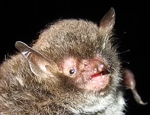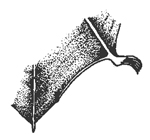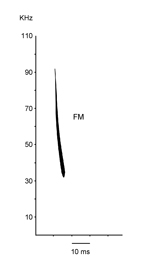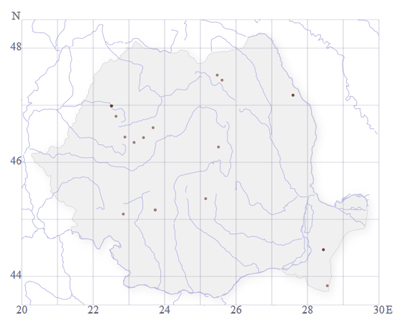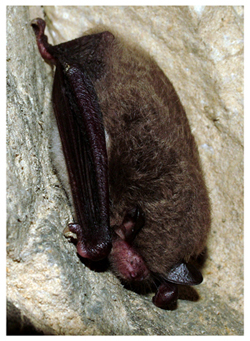Hibernáló vízi denevér egyed (fotó: Barti L.).
Egész Európában elterjedt, kivéve a Skandináv félsziget északi részein és egyes Mediterrán szigeteken.
Vízfolyások mentén levő szülőkolóniái általában faodvakban találhatóak, ahol akár 100 egyed is összegyűlhet. Hibernáló kolóniái ritkábban faodvakban, gyakrabban barlangokban találhatóak. Vadászterületei elsősorban víztestek fölött vagy azok közelében vannak, de akár erdőkben vagy parkokban is. Táplálékát túlnyomórészt szúnyogok, kérészek és tegzesek teszik ki. Közepes távon vándorló faj. Átlagéletkora 4.5 év, a legmagasabb feljegyzett életkor 30 év.
Gyakori faj, populációi növekvő tendenciát mutatnak, mely a vizek fokozott eutrofizációjának tudható be (maga után vonva a fajspecifikus táplálékforrás növekedését). Védelmi intézkedések lehetnek a szálláshelyként használt odvak, erdők, illetve a hibernáló kolóniákat befogadó barlangok védelme.
Baltag E., Pocora I., Pocora V. (2009): Chiropterofauna din aria Cheile Bicazului, Cheile Şugăului, Peştera Toşorog (A Békási-szoros, Súgó-szoros és Toşorog barlang denevérfaunája). Migrans, XI(1): 2-4.[PDF]
Barti L. (2002d): A Daday Jenő által létrehozott denevérgyűjtemény a kolozsvári Állattani Múzeumban. Múzeumi Füzetek, 11: 67-72.[PDF]
Barti L., Dóczy A., Jére Cs., Varga Á. (2006): Rezultatele recensământului de lilieci în locurile de hibernare subterane în Sud-estul Transilvaniei. First Conference on Bat Conservation in Romania, Book of abstracts, Ed. Romanian Bat Protection Association, p.13.[PDF]
Barti L., Dóczy A., Jére Cs., Varga Á. (2007): Denevér-telelőhely ellenőrzések eredményei Délkelet-Erdélyben. Proceedings of the 5th Conference of the Bat Conservation in Hungary (Pécs, 3th to 4th of December 2005) and 6th Conference of the Bat Conservation in Hungary (Mártély, 12th to 14th of October 2007), Magyar Denevérkutatók Baráti Köre, Budapest, p. 51-62.[PDF]
Barti L., Jére Cs., Dóczy A., Szodoray-Parádi F. (2007): A Vargyas-szoros recens és szubfosszilis denevérfaunája és faunisztikai adatbázisa a kezdetektől 2007 februárjáig. Acta Siculica, p. 153-178.[PDF]
Bielz E.A. (1856): Fauna der Wirbelthiere Siebenbürgens, eine systematische Aufzählung und Beschreibung der in Siebenbürgen vorkommenden Säugethiere, Vögel, Amphibien und Fische. Verein für siebenbürgische Landeskunde, Sibiu, p. 3-6.[PDF]
Bielz E.A. (1886): Über die in Siebenbürgen vorkommenden Fledermäuse. Verhandlung und Mittheilungen des siebenbürgischen Vereins für Naturwissenschaften, Sibiu, 36: 76-84.[PDF]
Bielz E.A. (1888): Die Fauna der Wirbeltiere Siebenbürgens nach ihren gegenwärtigen und jetzigen Bestande. Verhandlung und Mittheilungen des siebenbürgischen Vereins für Naturwissenschaften, Sibiu, 38: 15-36.[PDF]
Borda D. (2002): Chiropterele. in: Racoviţă Gh., Moldovan O., Onac B. (ed.): Monografia carstului din Muntii Padurea Craiului, Studiu monografic. Presa Universitară, Cluj-Napoca, p. 172-182.[PDF]
Chachula O., Valenciuc N., Done A. (2008): Contributions to the study of Chiroptera from Moldavia (Romania). Analele Ştiinţifice ale Universităţii "Al. I. Cuza" Iaşi, ser. Biologie animală, 54: 237-244.[PDF]
Chiş T., Manole M.G. (2005): Liliacul de apă (Myotis daubentoni Kuhl 1819) specie prezentă în Maramureş. Acta Musei Maramoresiensis, 3: 383-385.[PDF]
Daday J. (1885a): Előleges jelentés az erdélyi múzeum egylet igazgatóválasztmányának megbízásából az 1884-ik év nyarán tett chiropterológiai gyűjtések eredményéről. Orvos-Természettudományi Ėrtesitő, Kolozsvár, X(3), VII(1): 60-64.[PDF]
Daday J. (1885b): Jelentés az Erdélyi Országos Muzeum-Egylet igazgató-választmányának megbízásából az 1885-ik év nyarán végzett chiropterologiai gyűjtések eredményéről és az Erdélyi Múzeum-Egylet denevérgyűjteményének jegyzéke. Orvos-Természettudományi Értesítő, Kolozsvár, X(3), VII(3): 266-276.[PDF]
Daday J. (1887): Új adatok Erdély denevérfaunájának ismeretéhez. Magyar Tudományos Akadémia, Értekezések a Természettudományok köréből, Budapest, XVI(7): 1-47.[PDF]
Dobrosi D., Gulyás J. (1997): A bihari barlangok denevérei. Proceedings of the 1st Conference on Bat Conservation in Hungary, Magyar Denevérkutatók Baráti Köre, Budapest, p. 34-36.[PDF]
Herman O. (1869): A Mezőség I. A Hódos- vagy Szarvas-tó és környéke természetrajzi, jelesen állattani szempontból tárgyalva. Az Erdélyi Muzeum Egylet Évkönyvei, Kolozsvár, V(1): 8-29.
Hermanns U., Pommeranz H., Schütt H. (2002): Zur Fledermausfauna (Chiroptera) des rumänischen Dobrudscha-Karstes unter Berücksichtung möglicher Gefährdungsursachen. Nyctalus, 8(4): 379-388.[PDF]
Ifrim I., Pocora V. (2006): Aspecte preliminare privind studiul chiropterelor din Pădurea Letea. First Conference on Bat Conservation in Romania. Book of Abstracts, Ed. Romanian Bat Protection Association, p. 6.[PDF]
Ifrim I., Pocora V. (2007a): Preliminary aspects about the specific composition of the bats fauna from three caves of Dobrogea. Analele Ştiinţifice ale Universităţii "Al I. Cuza", Iaşi, ser. Biologie animală, 53: 239-244.[PDF]
Ifrim I., Pocora V. (2007b): Preliminary aspects about the study of bats from Letea Forest - Danube Delta. Scientific Annals of the Danube Delta Institute, 13: 27-34.[PDF]
Jére Cs., Dóczy A. (2005): Data on the bat fauna of the upper part of the Târnava rivers basin (Transylvania, Romania). in Curtean-Bănăduc Angela, Bănăduc D. & Sîrbu I. (ed.): Transylvanian Review of Systematical and Ecological Research, 2. The Târnava River Basin, Sibiu, p. 167-172.[PDF]
Jére Cs., Dóczy A., Barti L. (2007): Results of research on the bat fauna of the Vârghiş Gorge (Eastern Carpathians, Romania). Travaux de l'Institut de Spéologie "Émile Racovitza", XLV-XLVI, p. 59-74. [PDF]
Murariu D., Decou V., Gheorghiu V. (2004): Bat specific structure over the year in the Gura Ponicovei Cave from South-Western Carpathians (Romania). Travaux du Museum National d'Histoire Naturelle "Grigore Antipa", XLVII: 315-323.[PDF]
Nagy L.Z., Barti L., Dóczy A., Jére Cs., Postawa T., Szántó L., Szodoray-Parádi A., Szodoray-Parádi F. (2005): Survey of Romania's underground bat habitats Carpathian's underground bat habitats. Status and distribution of cave dwelling bats (2002-2004). Final report for the BP Conservation Programme. Survey of Southern and Western Carpathians underground bat habitats & Survey of Eastern Carpathians and Dobrogea underground bat habitats, Ed. Lizard, Cluj, pp. 44.[PDF]
Szántó L. (2000): Study of Bat communities of the Water-Cave of Leşu (Pădurea Craiului Mountains - Romania). Abstract. Proceedings of the 3rd International Conference "Bats of Carpathian Region, Rakhiv, Ukraine, Novitatis Theriologicae 1(4): 9.
Szodoray-Parádi F., Szodoray-Parádi A. (2005): Results on the investigatin on bats fauna in Vânători Neamţ Natural Park and conservation status of the occurring bat species. Studies and research in Vânători Neamţ Natural Park, I: 93-98.[PDF]
Topál Gy. (1954): A Kárpát-medence denevéreinek elterjedési adatai. A Magyar Nemzeti Múzeum Természettudományi Osztályának Évkönyve, Budapest, 46: 471-483.[PDF]
- Bogdanowicz W. (1994): Myotis daubentonii. Mammalian Species 475: 1-9.
- Dietz C., Helversen O., Nill D. (2007): Myotis daubentonii. Handbuch der Fledermäuse Europas und Nordwestafrikas. Kosmos Verlag, Stuttgart. Pp. 200-207.
- Roer H., Schober W. (2001): Myotis daubentonii (Leisler 1819) - Wasserfledermaus. Pp. 257-280. In: Krapp F. (ed.): Handbuch der Säugetiere Europas. Band 4: Fledertiere. Teil I: Chiroptera I. Rhinolophidae, Vespertilionidae 1. Aula-Verlag, Wiebelsheim.











